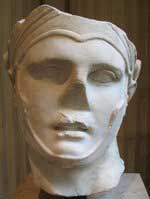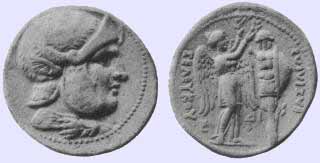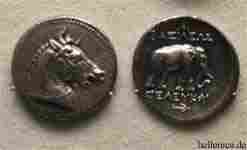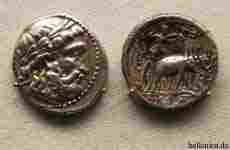.

Seleucus I (surnamed for later generations Nicator, in Greek:Σέλευκος Νικάτωρ") (c. 358 BC–281 BC), Macedonian officer of Alexander the Great. In the wars of the Diadochi, after Alexander's death, he established the Seleucid dynasty and Seleucid Empire.
Early career & ascent to power
Seleucus was the son of Antiochus, one of Philip's generals. As a young man of about twenty-three, he accompanied Alexander into Asia in 333 BC, and won distinction in the Indian campaign of 326 BC. When the Macedonian empire was divided in 323 BC (the "Partition of Babylon") Seleucus was given the office of chiliarch, which attached him closely to the person of the regent Perdiccas. Seleucus himself had a hand in the murder of Perdiccas in 321 BC.
At the second partition, at Triparadisus (321 BC), Seleucus was given the government of the Babylonian satrapy. In 316 BC, when Antigonus had made himself master of the eastern provinces, Seleucus felt himself threatened and fled to Egypt. In the war which followed between Antigonus and the other Macedonian chiefs, Seleucus actively cooperated with Ptolemy and commanded Egyptian squadrons in the Aegean Sea.
The victory won by Ptolemy at the battle of Gaza in 312 BC opened the way for Seleucus to return to the east. His return to Babylon in that year was afterwards officially regarded as the beginning of the Seleucid Empire. Master of Babylonia, Seleucus at once proceeded to wrest the neighbouring provinces of Persia, Susiana and Media from the nominees of Antigonus. A raid into Babylonia conducted in 311 BC by Demetrius, son of Antigonus, did not seriously check Seleucus's progress. Whilst Antigonus was occupied in the west, Seleucus over the course of nine years (311-302 BC) brought under his authority the whole eastern part of Alexander's empire as far as the Jaxartes and Indus Rivers. In 305 BC, after the extinction of the old royal line of Macedonia, Seleucus, like the other four principal Macedonian chiefs, assumed the title and style of King.
Establishing the Seleucid state
His attempt, however, to restore Macedonian rule beyond the Indus, where Chandragupta Maurya had established himself, was not successful. Seleucus entered the Punjab, but after humiliating defeats in 302 BC, was forced to conclude a peace with Chandragupta, by which he ceded large districts of what is now Afghanistan, and his daughter Helen as a "hostage-concubine", to Chandragupta.
In 301 BC he joined Lysimachus in Asia Minor, and at Ipsus Antigonus fell before their combined power. A new partition of the empire followed, by which Seleucus added to his kingdom Syria, and perhaps some regions of Asia Minor. The possession of Syria gave him an opening to the Mediterranean, and he immediately founded here the new city of Antioch upon the Orontes as his chief seat of government. His previous capital had been the city of Seleucia, which he had founded upon the Tigris (almost coinciding in site with Baghdad), and this continued to be the capital for the eastern satrapies. About 293 BC he installed his son Antiochus there as viceroy, the vast extent of the empire seeming to require a double government.

Silver coin of Seleucus. Greek inscription reads ΒΑΣΙΛΕΩΣ ΣΕΛΕΥΚΟΥ (king Seleucus). [Source]
The capture of Demetrius in 285 BC added to Seleucus's prestige. The unpopularity of Lysimachus after the murder of Agathocles gave Seleucus an opportunity for removing his last rival. His intervention in the west was solicited by Ptolemy Keraunos, who, on the accession to the Egyptian throne of his brother Ptolemy II (285 BC), had at first taken refuge with Lysimachus and then with Seleucus. War between Seleucus and Lysimachus broke out, and at the decisive battle of Corupedium in Lydia, Lysimachus fell (281 BC). Seleucus now held the whole of Alexander's conquests excepting Egypt in his hands, and moved to take possession of Macedonia and Thrace. He intended to leave Asia to Antiochus and content himself for the remainder of his days with the Macedonian kingdom in its old limits. He had, however, hardly crossed into the Chersonese when he was assassinated by Ptolemy Keraunos near Lysimachia (281 BC).
Links
A genealogical tree of Seleucus (http://freepages.genealogy.rootsweb.com/~jamesdow/s008/f069878.htm)


Seleucus I Nicator, Seleucus I Nicator, Seleucia on the Tigris,
References
Seleukos Nikator: Constructing a Hellenistic Kingdom by John D. Grainger ISBN 0415047013
This article incorporates text from the public domain 1911 Encyclopædia Britannica.
See also
Seleucid King 312/305 –281 BC
Preceded by: (Alexander IV)
Succeeded by: Antiochus I Soter
| Ancient Greece
Science, Technology , Medicine , Warfare, , Biographies , Life , Cities/Places/Maps , Arts , Literature , Philosophy ,Olympics, Mythology , History , Images Medieval Greece / Byzantine Empire Science, Technology, Arts, , Warfare , Literature, Biographies, Icons, History Modern Greece Cities, Islands, Regions, Fauna/Flora ,Biographies , History , Warfare, Science/Technology, Literature, Music , Arts , Film/Actors , Sport , Fashion --- |
Retrieved from "http://en.wikipedia.org"
All text is available under the terms of the GNU Free Documentation License

